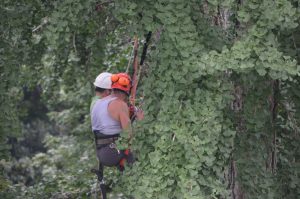Save the Trees
“I wish people would put as much emphasis on their trees as their lawns,” said Joel Koci, a certified arborist with the Urban Forestry Extension of Virginia State University. “Trees are much more ecologically advantageous.”

This 175-year-old oak (Quercus alba) exhibited overextended branches that stress the tree’s structure, so end-reduction pruning was recommended.
According to Koci, man’s actions and lack of knowledge are two of the greatest threats to trees. “People pressure”—such as new construction, paved driveways or turf planted directly under trees—can threaten a tree’s health. Later if symptoms appear, alarmed homeowners call with concern that their tree is unhealthy or perhaps dying.
“Typically, when a layperson sees a situation [related to poor tree health], it’s the point of no return,” Koci said. “What you see today is the symptom from three years previous.”
Koci, who has a master’s degree in horticulture and 40 years of tree-care experience, is on mission to educate people about the proper care and value of trees.
“I killed a lot of trees early in my career,” he admitted, “but now we’re more holistic. We look at the entire tree to find optimum health.” From the scientific point of view, a tree has three organs: leaves, conductive tissues (twigs and trunks) and roots. If an organ is damaged or diseased and left untreated, the tree’s overall health may be negatively impacted over time.
When lecturing among professional groups and homeowners, Koci recommends continual surveillance of trees – especially when a tree is older or part of a property’s legacy. He and other certified arborists support a three-fold inspection process that analyzes structure, biological aspects and soil. First and foremost is the structural inspection.

This mulberry tree (Morus rubra), a legacy tree in the Children’s Garden at Lewis Ginter Botanical Garden, is more than 100 years old. Professional arborists carefully removed dead or compromised branches to help extend the tree’s life. They also placed props beneath select, low-lying branches to preserve the tree’s integrity and to take the weight of young climbers.
“Everyone wants to start up close, but instead, stand back and look at the overall silhouette or periphery,” Koci said. “If the center is noon and you see dieback in the outer canopy from 10 o’clock to 2 o’clock, you might have root disruption.” In this case, the roots may not be able to provide sufficient nutrients to satisfy the top of the tree. However, if dieback appears on interior branches, normal shading may be the cause and there is less need for concern. Whatever the reason, stressed and dead branches should be properly addressed, since they may pose safety risks to people, nearby structures and the tree itself.

Certified arborist Joel Koci climbs a mature oak tree in preparation for end-weight pruning of select branches.
After analyzing from a distance, it’s time for a closer look. Are there forked branches that weaken the overall structure? Are branches tight or at right angles? Other defects may appear as rotted wood, along with mushrooms or fungus. Harmful insects may be present, but not necessarily visible. Symptoms of insect infestation may appear as black watery ooze or fermented sap along the bark that tends to attract butterflies and bees.
Next, check the soil. Compaction around the trunk can occur during building and road construction. Heavy compaction not only limits porosity; it reduces the roots’ ability to extract oxygen from water. To analyze the soil itself, take various samples as directed by the Virginia Tech Soil Testing Laboratory or other reliable labs. The test results reveal pH and whether vital nutrients are missing. Don’t forget to review mulching practices, too. Excess mulch heaped around the base of a tree, known as a mulch volcano, invites insect and wildlife infestation. Mulch should be no closer than around 5 or 6 inches from the trunk and no more than 3 inches deep.
The second inspection concentrates on biological aspects, such as analysis of leaf size and color. Comparing the tree’s leaves with others from the same species, age and similar location helps an arborist determine if the tree is healthy. It can reveal additional evidence of harmful insects or disease, as well.
In addition to periodic structural and biological inspections, trees benefit from regular maintenance that helps prevent limb separation and breakage.
“Don’t wait until after a storm and arbitrarily cut limbs,” Koci said. “Instead, work with the tree … and make it more stable through proper pruning that starts in the [tree’s] early stage.” End-weight-reduction pruning, which is 80 percent of most pruning, strategically reduces the length of over-extended limbs. The procedure reduces torque and overall pull on the tree’s trunk and roots, helping decrease vulnerability. If doubtful about proper pruning, review step-by-step resources or contact an arborist.
Ongoing tree inspections and continued care may be labor intensive, but optimizing a tree’s health brings satisfaction. It also helps support longevity and ecological benefits.
“We never do it for ourselves,” Koci said. “We do it for future generations.”
For Additional Help with Trees
County extension agents may provide helpful resources related to tree health.
If additional consultation or maintenance is needed, contact a tree-care professional, such as one credentialed with the International Society of Arboriculture.
Obtain more than one assessment and estimate, ask questions and select a knowledgeable arborist with whom you have confidence and rapport.
Other Resources on Trees
www.treebenefits.com provides a calculator that quantifies the ecological benefits of a tree in terms of stormwater retention, energy savings, air quality, property value and more.
www.treesaregood.com overviews proper tree care, educational offerings and lists of certified arborists.
www.treesvirginia.org offers tree planting and maintenance tips, plus helpful links to related state and national organizations.
___________
This article first published in the Richmond Times-Dispatch in May 2017.